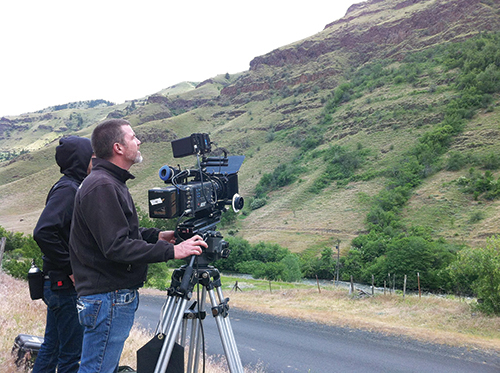
“Thirty-four men, 11 names,” narrator Robert Longstreet intones in his husky baritone, laying out the arresting and poignant details of the heinous crime at the center of the recent documentary Massacred for Gold. “They might have helped build railroads, drain land, farm crops…They lived mostly anonymous and they died anonymous,” Longstreet says, their remains “crushed as fine as the gold they once mined.”
Longstreet (Take Shelter, Pineapple Express) provides the only voice the viewer hears in
Vernon Lott and Jennifer Anderson’s film, which is based on a book by longtime Oregonian reporter R. Gregory Nokes.
Massacred will screen this Thursday at the Northwest Film Center, and Nokes and the film’s cinematographer, Ryan K. Adams, will be in attendance to take questions from the audience after the screening.
The American West of the 1880s—really, all of the U.S.—was a dangerous place to be a Chinese immigrant.
In 1882, President Chester Arthur signed the Chinese Exclusion Act into law, and though it was intended to last a mere 10 years, it was not repealed until 1943. The passage of the act precipitated drastic, racist action from whites across the Northwest, recounted matter-of-factly by Longstreet.
In Idaho, 300 Chinese immigrants were rounded up and dropped off in the woods in the dead of winter; in Washington, 400 were taken from their homes and shipped to California; and in Oregon, Chinese immigrants were given 30 days to leave the state or face the implicit (and occasionally explicit) threat of violence.
Massacred tells the story of “the worst homicide of Chinese at the hands of whites in the American West,” as Anderson (who also wrote the film) puts it.
The year was 1887, and the victims of the crime were Chinese immigrants who had entered the country in either Portland or San Francisco with the help of the Sam Yup Company, which served as the men’s employer and union.
They most likely immigrated to work on the railroad, and when work on that was complete, “they might have been laid off—they might have turned to mining to survive,” as Massacred tells it.
Mining was difficult, dangerous work made more difficult for Chinese immigrants, who were only allowed to mine claims that had already been stripped nearly bare by white miners.
This loosely organized group of Chinese men—34 in total, 11 with known names—worked its way from the China Town settlement in Lewiston, Idaho, down the Snake River to Oregon’s Hell’s Canyon, mining for gold over the eight months they traveled.
By late May, they had arrived in Oregon at what they called “Gun Sam,” or Gold Mountain. And, unfortunately for these Chinese immigrants, a band of seven “cattle rustlers and schoolboys” were ready for them, planning an ambush that they would carry out on May 25 and 26, 1887, on the banks of the Snake River.
These seven white men were led by “Blue” Evans and Titus Canfield, two thieves and cattle rustlers who “had probably killed before.” Canfield, a “risk-taking cowboy with bright red hair,” had been arrested just two weeks prior for stealing 150 horses.
On the morning of May 25, one man stayed behind to cook breakfast while the other six set off for the riverbanks where they knew the Chinese immigrants were sifting for gold.
We don’t know precisely what happened next, but we do know this: In the course of two days, 34 Chinese miners were killed—most shot in the back, some beheaded and chopped with axes and one bludgeoned to death with either a rock or a piece of driftwood.
The seven men allegedly made off with roughly $50,000 in gold, and none of them were ever convicted of a crime. (Though Evans, Canfield and another man, Larue, were indicted, authorities never pursued them with any vigor.)
Massacred for Gold is a meditative, pensive piece that, because of the hazy nature of the events it covers, deals largely in hypotheticals; the film is littered with “might have”s and “we don’t know”s.
Visually, Lott and Anderson elect to accompany Longstreet’s narration with slow black-and-white pans across the jagged cliffs and crags of Hell’s Canyon, giving the viewer a palpable sense of where these miners suffered and died.
The filmmakers also make use of numerous photos and political cartoons, and the latter especially provide evocative visual evidence of the political climate of the time and the extent to which Chinese-Americans were persecuted.
Massacred for Gold
Part of the Northwest Tracking Series
Thursday, April 11, 7 p.m.
Followed by a Q-and-A with author R. Gregory Nokes and
cinematographer Ryan K. Adams
At only 76 minutes, Massacred for Gold is a short film, but the visuals become monotonous, going from ruminative to snooze-worthy.
With little in the way of visual payoff, I found myself wanting to read Nokes’ book or shut my eyes and imagine I was listening to Longstreet recording a podcast. Though Hell’s Canyon is stark and beautiful, it’s not enough to occupy an entire feature-length film.
But the most important and astonishing part of Massacred for Gold is simply that the story exists in the first place: No testimony or court records of the event exist, there was little in the way of news coverage and what records did survive were locked in a safe in Paradise, Ore., until recently.
Massacred for Gold is a vital piece of work, not for the cinematic joy it arouses but for the righteous anger and ethical questions it provokes—feelings that remain lodged in the recesses of your brain long after the closing credits have rolled.
It is a fitting tribute to a group of men whose story has gone untold for too long.

